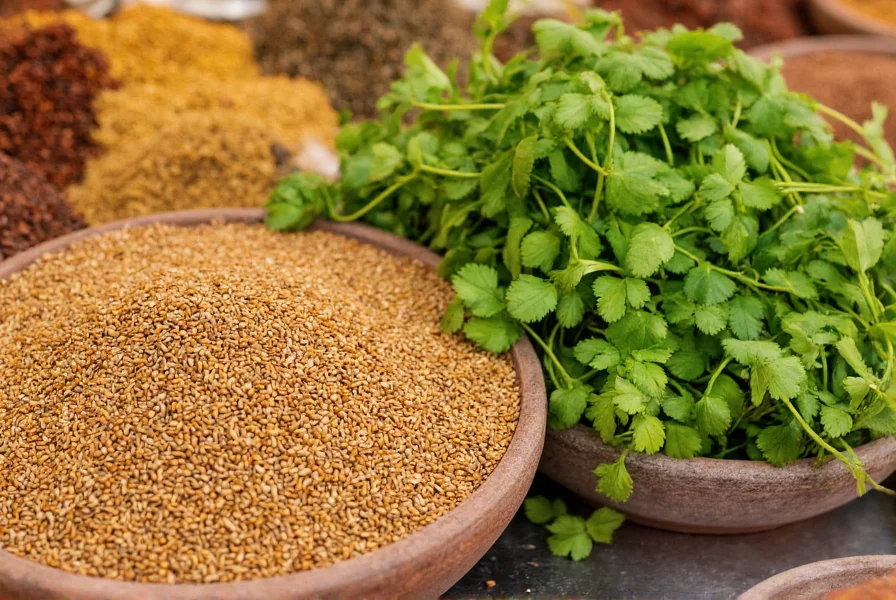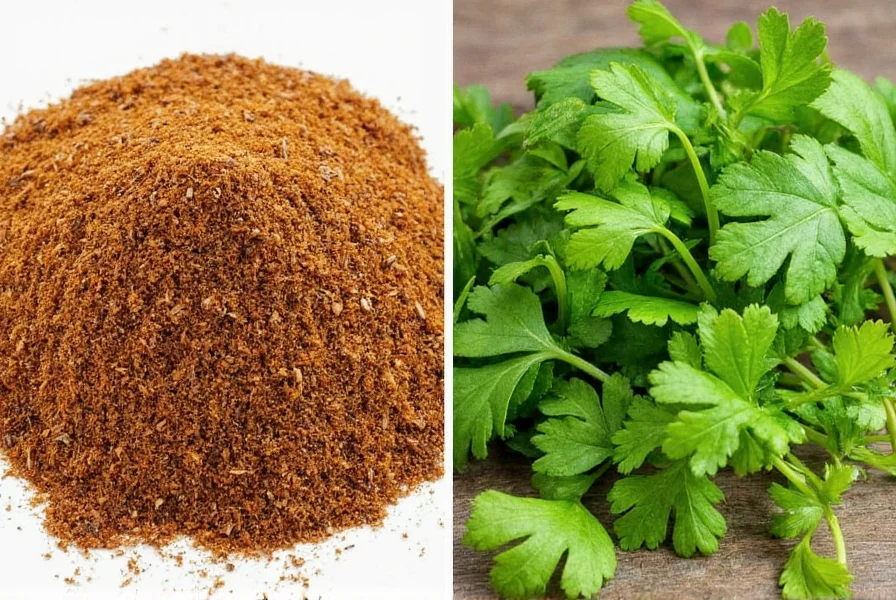Cumin and cilantro are completely different ingredients: cumin is a warm, earthy spice made from dried seeds, while cilantro refers to the fresh leaves of the coriander plant with a bright, citrusy flavor. They come from different plants, have distinct flavor profiles, and serve different culinary purposes—confusing them can dramatically alter a dish's taste.
Many home cooks and even experienced chefs occasionally mix up cumin and cilantro, but understanding their fundamental differences is essential for authentic cooking. This comprehensive guide breaks down everything you need to know about these two ingredients that frequently appear in global cuisines but serve entirely different roles in the kitchen.
What Exactly Is Cumin?
Cumin (Cuminum cyminum) is a flowering plant in the Apiaceae family, but what we use as cumin is actually its dried seeds. These small, crescent-shaped seeds have been used as a spice for thousands of years across Middle Eastern, Indian, North African, and Latin American cuisines. When whole, cumin seeds have a relatively mild aroma, but toasting and grinding them releases their distinctive warm, earthy, slightly smoky flavor with subtle citrus notes.
Cumin's flavor profile makes it a cornerstone in spice blends like garam masala, chili powder, and curry powders. It's essential in dishes ranging from Indian curries to Mexican mole and Moroccan tagines. The spice contains cuminaldehyde, which gives it its characteristic aroma and offers potential digestive benefits according to culinary tradition.
Understanding Cilantro: More Than Just Fresh Leaves
Cilantro refers specifically to the fresh leaves and stems of the Coriandrum sativum plant—the same plant that produces coriander seeds (which are completely different from cumin). In the United States and some other countries, we call the fresh herb "cilantro" while the dried seeds are called "coriander." This naming convention is a primary source of confusion when comparing cumin vs cilantro.
Fresh cilantro delivers a bright, citrusy flavor with herbal notes that some describe as soapy (due to a genetic predisposition affecting certain individuals). It's a staple in Mexican, Southeast Asian, and Indian cuisines, typically added at the end of cooking or used as a garnish to preserve its delicate flavor. Unlike cumin, which benefits from toasting, cilantro's flavor diminishes quickly with heat.
| Characteristic | Cumin | Cilantro |
|---|---|---|
| Plant Source | Cuminum cyminum seeds | Leaves of Coriandrum sativum |
| Form Used | Dried seeds (whole or ground) | Fresh leaves and stems |
| Flavor Profile | Earthy, warm, slightly smoky, with citrus undertones | Bright, citrusy, herbal (soapy to some) |
| Heat Tolerance | Improves with cooking; added early | Loses flavor with heat; added at end |
| Storage | Years in airtight container | Days in refrigerator |
| Primary Cuisines | Middle Eastern, Indian, Mexican, North African | Mexican, Southeast Asian, Indian |
Why People Confuse Cumin and Cilantro
The confusion between cumin vs cilantro stems from several factors. First, both ingredients prominently feature in Mexican and Indian cuisines, leading many to assume they're related. Second, the coriander plant produces both cilantro (leaves) and coriander seeds—and "coriander" is sometimes confused with "cumin" due to similar-sounding names. Finally, many recipes list "coriander" without specifying whether they mean the seeds or leaves, adding to the confusion.
Understanding the difference between cumin and cilantro is particularly important when following recipes from different cultural contexts. In British English, "coriander" refers to both the seeds and leaves, while in American English, "cilantro" specifically means the fresh herb. This linguistic difference causes frequent misunderstandings in international cooking communities.
Culinary Applications: When to Use Each
Cumin shines in dishes that benefit from deep, earthy notes. It's essential in chili, taco seasoning, hummus, and many Indian curries. Because cumin's flavor compounds are fat-soluble, blooming the spice in oil at the beginning of cooking maximizes its flavor impact. Ground cumin works well in rubs and marinades, while whole seeds add texture to rice dishes and pickling brines.
Cilantro, by contrast, brings freshness to dishes. It's indispensable in pico de gallo, guacamole, Thai curries, and Vietnamese pho. Unlike cumin, which develops flavor with cooking, cilantro's volatile oils dissipate with heat, so it's best added just before serving. The stems contain concentrated flavor and work well in marinades and curry bases, while the leaves serve as garnish.
Substitution Guidance: Can You Replace One With the Other?
When considering whether you can substitute cumin for cilantro (or vice versa), the answer is generally no—they're too different. However, understanding appropriate alternatives can save a recipe:
- If you need cumin but don't have it: Try a blend of coriander seed, oregano, and a pinch of smoked paprika. Caraway has some similar earthiness but is stronger.
- If you need cilantro but don't have it: Use flat-leaf parsley with a squeeze of lime juice for freshness. Basil or mint can work in some Southeast Asian dishes.
- For cilantro-haters: Some people genetically perceive cilantro as soapy. For them, Mexican recipes often substitute epazote or papalo for authentic flavor.
Understanding what does cumin taste like compared to cilantro helps explain why direct substitution doesn't work. Cumin provides warm depth while cilantro offers bright top notes—they function differently in flavor layering.
Storage Techniques for Maximum Freshness
Proper storage significantly impacts how long these ingredients maintain their flavor. Cumin seeds retain potency for 3-4 years when stored in an airtight container away from light and heat. Ground cumin loses flavor more quickly—within 6 months—so buying whole seeds and grinding as needed yields superior results.
Cilantro requires different handling. To extend its life, trim the stems and place in a glass with an inch of water, covering loosely with a plastic bag in the refrigerator. This method keeps cilantro fresh for 1-2 weeks. Alternatively, chop the cilantro and freeze in olive oil cubes for cooking applications where appearance doesn't matter.
Global Cuisine Applications
Exploring cumin and cilantro in Mexican cooking reveals their distinct roles. Cumin appears in chili powders, adobo sauces, and refried beans, providing that characteristic earthy backbone. Cilantro features in salsas, guacamole, and as a finishing garnish on tacos and soups. While both appear in Mexican cuisine, they rarely interact directly in the same dish stage—cumin cooks into the base while cilantro freshens the finished product.
In Indian cooking, cumin seeds often start dishes with tempering (tadka), while fresh cilantro appears as garnish. Confusing cumin vs coriander (the seed) is more common than mixing up cumin vs cilantro, but understanding these distinctions elevates authentic cooking.

Final Considerations for Home Cooks
Mastering the difference between cumin and cilantro transforms your cooking accuracy. Remember that cumin is always a dried spice while cilantro refers only to the fresh herb. When recipes call for "coriander," check whether they mean the seeds (common in British recipes) or leaves (inconsistent usage). Building this knowledge helps prevent the common mistake of adding ground cumin when a recipe actually requires fresh cilantro—a substitution that would completely alter the dish's character.
As you develop your palate, you'll learn to identify cumin's warm depth versus cilantro's bright freshness in dishes. This sensory awareness helps troubleshoot recipes and develop your own flavor combinations with confidence.
Can I use cilantro instead of cumin in chili?
No, cilantro cannot substitute for cumin in chili. Cumin provides the earthy base flavor essential to chili, while cilantro would add an incompatible fresh, citrusy note. If you lack cumin, try a mix of coriander seed, oregano, and smoked paprika instead.
Why do some people think cumin and cilantro taste the same?
They don't taste similar, but confusion arises because both appear in similar cuisines like Mexican and Indian cooking. Additionally, the word "coriander" refers to both the plant that produces cilantro leaves and its seeds, which some mistake for cumin due to similar naming.
Does cilantro turn into cumin when dried?
No, cilantro leaves and cumin seeds come from completely different plants. Drying cilantro creates dried cilantro (which loses most flavor), while cumin comes from the dried seeds of a different plant. Coriander seeds come from the same plant as cilantro, but these are still different from cumin.
How can I tell if a recipe means cilantro or coriander?
Check the recipe's origin and context. American recipes typically say "cilantro" for leaves and "coriander" for seeds. British recipes often use "coriander" for both. If it specifies "fresh" or "leaves," it means cilantro; if it says "seeds" or appears in a spice blend, it's coriander seeds.
What's the best way to use both cumin and cilantro in the same dish?
Use cumin early in cooking to develop its earthy flavor (toast seeds in oil first), then add fresh cilantro at the end as garnish. This technique appears in authentic Mexican moles and Indian raitas, where cumin provides depth in the base while cilantro adds fresh contrast.












 浙公网安备
33010002000092号
浙公网安备
33010002000092号 浙B2-20120091-4
浙B2-20120091-4